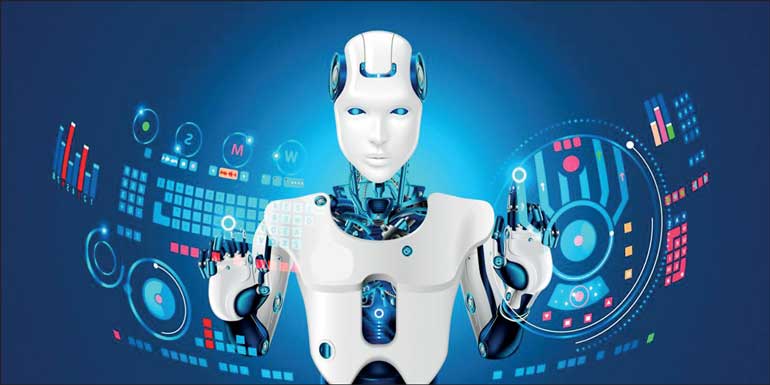Wednesday Nov 19, 2025
Wednesday Nov 19, 2025
Wednesday, 13 October 2021 00:05 - - {{hitsCtrl.values.hits}}

The optimistic futurists among us will embark on a worthy journey that would bring enlightenment in the future direction of technology
 |
| Dr. Rangamini Werawatte
|
Humans with their constant curiosity and taste for advancement are known for seeking avenues to enhance their ever-changing lifestyle. The future beckons us as a formidable force. Are you ready to embrace technological innovation or be beaten in the race for survival? Will man have supremacy over machines and will we soon be living in an age where all routine work will be totally automated?
COVID-19, a pandemic that has created upheaval and havoc in our everyday lives, is the stark reality that tech is the way forward. Did you ever stop to think how all online work could have been a possibility if not for the advent of the internet? The paramount importance of working online is the rule of the day. All industries across the board depend on online transactions for survival, a scenario unheard of in the past. But the truth is here to stay.
Dr. Rangamini Werawatte, Director – School of IT Nagananda International Buddhist University shared his expertise and insights on a timely technological topic discussed widely. Industry 4.0 is a catalyst in the IT sector creating waves and touching human lives to change the shapes of our daily mundane routines to a more vibrant one. Industry 4.0 is fundamentally about human-machine and machine to machine communication. Thus, taking technology to a whole new level.
 The history of the industrial revolutions
The history of the industrial revolutions
Dr. Werawatte outlined the historical significance of the 1st, 2nd and 3rd Industrial Revolutions for want of knowledge to better grasp the concept of Industry 4.0. “The industrial revolutions in general are a huge change in the process of how the assembly lines were transformed from a predominantly man-handled to machine-handled process. In 1784 with the use of steam power, the mechanised production of equipment was introduced to the
automation of a factory. The weaving machine which was used manually at the beginning was later converted to steam power and thereafter a mechanical machine was produced to do what a human does. This process was much faster and more effective in the long run,” he adds introducing the 1st Industrial Revolution that occurred in the late 17th Century Europe.
According to Dr. Werawatte, the 2nd Revolution manifested in 1870 a hundred years after the 1st Industrial Revolution. “Electric power was being used in assembly lines and the concept of mass production widely being used for production,” he responds.
The world saw the 3rd Industrial Revolution in 1969; a good century after the 2nd Industrial Revolution. “The use of computers and technology along with the automation of production could be designated as the 3rd revolution. It was all about empowering corporations or organisations thus enabling work to be done faster, efficiently and more importantly cheaper. After the year 2000 with the development of technology, globalisation and introduction of super computers and the world wide web, we could see a meteoric rise in the technology super highway,” Dr. Rangamini Werawatte points out.
The 4th Industrial Revolution
That being said, Dr. Werawatte enunciated that the birth of Industrial Revolution 4.0 is associated with Klaus Schwab, Executive Chairman of the World Economic Forum (WEF) who was instrumental in introducing this term and concept in 2015. His idea was to coin the development achieved thus far to be utilised to better the way people were working. This new finding was embraced by mostly the ultra-techno enthusiasts which culminated in Industry 4.0 taking the world by storm so to say. Many diverse terms were used for this revolution but the most commonly used term is Industry 4.0.
Impact of Industry 4.0
According to Dr. Rangamini Werawatte, Industry 4.0 encompasses in general concepts such as Automation, Robotics, Artificial Intelligence (AI), Bit Data, Internet of Things (IOT), Blockchain, and 3D printing, to mention a few. “It’s all about connecting people with machines. There is another field that is gaining popularity called ‘Cybernetics’, where human evolution is discussed. As we are all aware there are many schools of thought on evolution i.e. what is the next human species? Anything reflecting their past ancestors being the homo neanderthal and homo sapiens? This is also an aspect of Industry 4.0 and it’s believed that in the future our conscience will be uploaded into a computer, so that even if your physical body dies, it could be downloaded. The human race is at a crossroad and at a literal turning point,” he explained.
Dr. Werawatte next explained the impact of Industry 4.0 that will be seen and felt in our lives sooner and not later. The Internet of Things (IOT) as the main area will connect machines to the internet, get machines to use internet and connect with each other (devices) on behalf of humans. According to him smart homes and smart phones use the internet and networks to connect other devices like phone/networks (like using Siri on Apple phones to search for information, order food, play music, help schedule your work) is a classic example to elaborate the impact of industry 4.0 on day-to-day human life.
“This technology (Smart homes/Google homes) is available in Sri Lanka now. The advantage of this is that you can automate your entire house. Just imagine you walk into your home and the lights will be switched on and dimmed to your desire and unnecessary lights will be switched off for you, enabling temperature control, ordering food and the list goes on. This is another application of Internet of Things (IOT).
There are also smart buildings and smart cities i.e. a building called ‘Edge’ in Netherlands is considered as the smartest building in the world today. “The remarkable feature is that the building can self-sustain and connect with other buildings/devices/people through internet. It enables to reserve an office space, direct you to your spot in the car park and electric vehicles will be directed to a spot where the vehicle can be charged are just some services which the ‘smart building’ concept has to offer,” says Dr. Werawatte.
3D printing
The building industry is positively impacted with the invention of 3D printing as with the other industries which also benefit directly with use of 3D printing. This is currently being used in some African countries. These houses are being built for low-income groups as 3D printing is relatively cheaper compared to traditional construction of houses. “3D printing has many facets such as printing inner ears for those with disability, the use of the printed ear is relatively more convenient than using a hearing aid. Artificial limbs and arms can be 3D printed for the use of those with disabilities. China is currently using 3D printing for building bridges,” he notes.
Big data
Another by-product of Industry 4.0 is the use of Bit data. Bit data is used in the health sector, disaster management for humanitarian purposes, and commercial purposes such as in stock market analysis. Bit data and Artificial Intelligence (AI) are utilised to predict the price of stocks and how the market operates. “An AI-based software called ‘Watson’ by IBM enables the user to record all his illnesses and once the symptoms are filled in, the software will search the data based on the information provided by the patient, predict the illness you have and propose a treatment plan,” adds Dr. Werawatte.
Blockchain
Blockchain technology is also a talking point in the biz circles and advanced economies, its wide spectrum covers the gamut of crypto currencies and Bitcoin. This technology is believed to challenge a nation’s currency if not used and regulated prudently. “People may want to buy crypto currencies instead of Dollars/Euros which may have repercussions on the relevant economy. These changes to the financial sector will come into practice as a result of Industry 4.0 he says.
Drones
Essentially anything that can be used for the purpose of serving mankind that is connected to another device through the internet is considered Industry 4.0. Drones also fall into this category. “Drones are being used widely in agriculture all over the world. It can be programmed to reach different heights for varied cultivation types. For example, it can be programmed to scan the vegetation area, water fertilise plants/trees, take photos and return to the place of origin. Some Sri Lankan plantations are already using drone technology in their cultivations,” he points out.
A drone can be programmed to fly for about 20-30 minutes and when it detects that it’s running out of battery it will return to its place of origin. However, in Sri Lanka drones are not widely used yet due to laws and regulations not being in place. The use of drones is restricted mainly for cultivation, filming and photography and military use.
Smart cars
Smart cards are yet another pivotal use of Industry 4.0 that have been put to good use in Western countries. “Smart cards are where you train the machine to function in different scenarios and train the machine to handle scenario safely. So, it can drive a car all the while commanding through the Artificial Intelligence (AI) of the vehicle to drive safely and to avoid accidents.
Wrapping up a very insightful and thought-provoking discussion on how things will be in the future, the optimistic futurists among us will embark on a worthy journey that would bring enlightenment in the future direction of technology. After all that has been said, one wonders if Industry 4.0 will replace humans.
It’s not that we use technology, we live technology – Godfrey Regio (American Director)
(The writer is a Journalist/Editor/Public Relations and Communication Specialist. She could be reached on [email protected].)